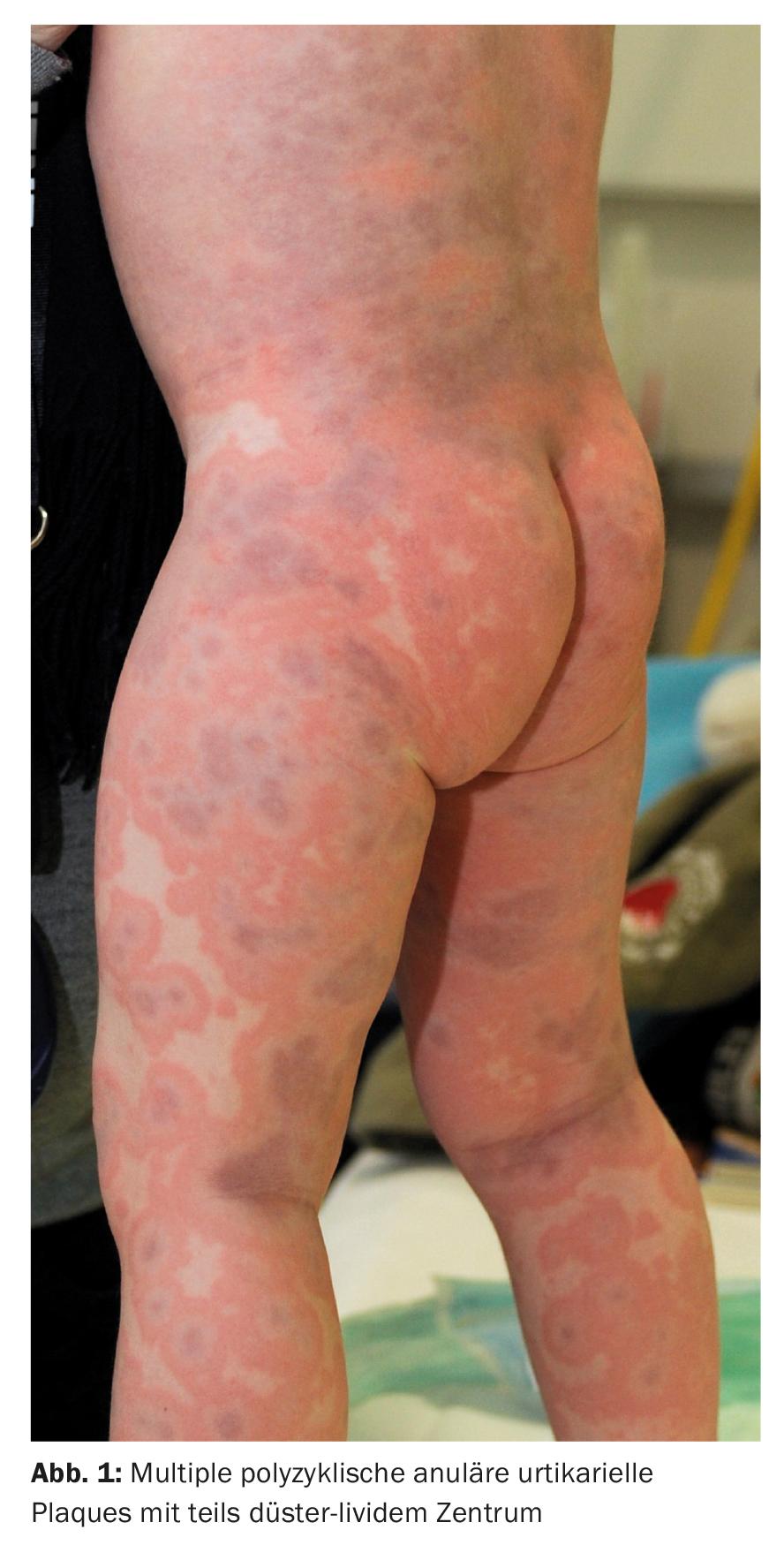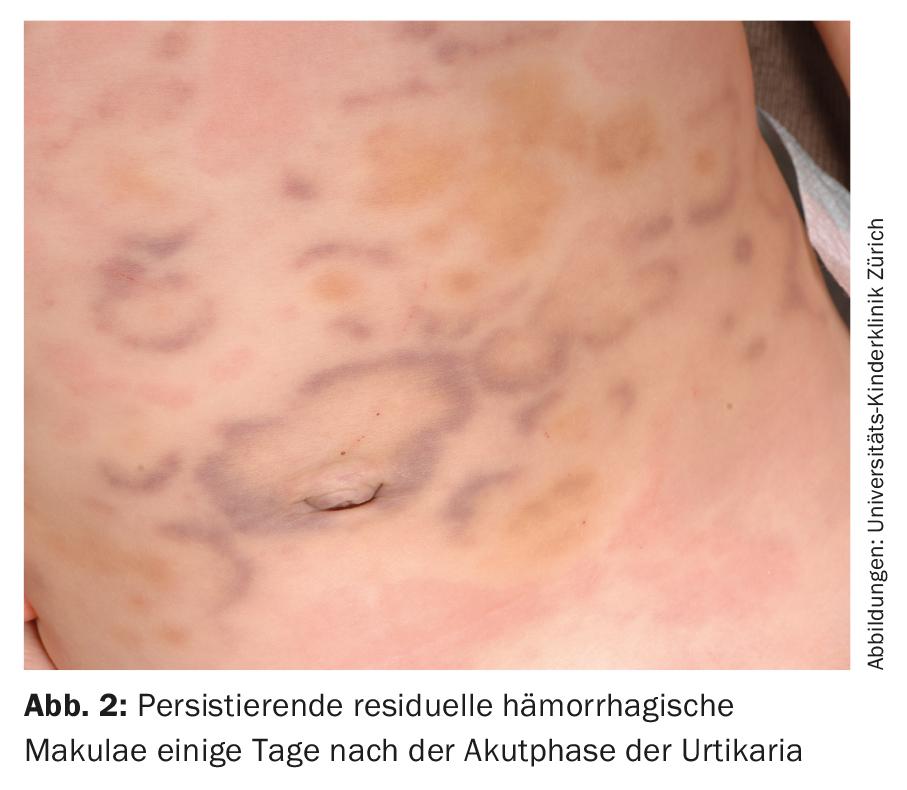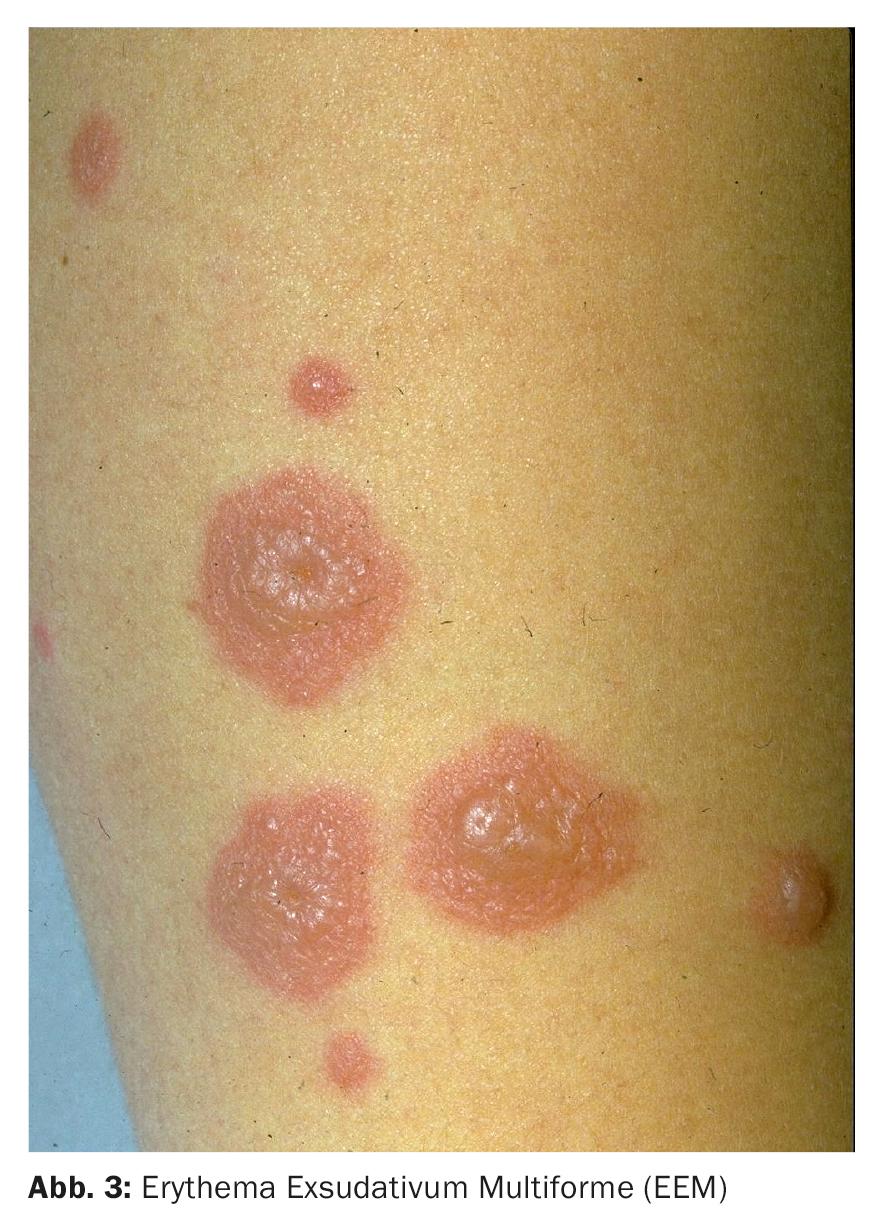Case report: The emergency presentation of the two-year-old boy is due to a pruritic, rapidly increasing rash that has been present for three days. He also complains of pain in both ankles. The mother tells that the boy has been suffering from runny nose and cough for a week, the occurrence of fever is denied. Except for a known hazelnut allergy, there are no known pre-existing conditions, and no medications have been taken.
Clinical picture: two-year-old boy in good AZ. Disseminated all over the body multiple polycyclic anular urticarial plaques with partly dusky-livid center (Fig. 1) . Erythema on both cheeks, smaller urticae frontally. Palmoplantar dark red swellings. Mucous membranes and genitals unremarkable. No lymphadenopathy.

Quiz
Based on this information, which is the most likely diagnosis?
A Urticariavasculitis
B Erythema Exsudativum Multiforme (EEM)
C Acute hemorrhagic edema of infancy.
D Urticaria multiforme
E Serum sickness
Diagnosis and Discussion: History and clinic are typical of urticaria multiforme – also called acute anular urticaria (Answer D). This is a morphologic subtype of acute urticaria typically seen in young children between the ages of a few months and four years. Clinically, each presents with urticarial plaques that rapidly expand to polycyclic, anular urticae with a somber, hemorrhagic center. As in acute urticaria, the single efflorescence usually persists for less than 24 hours, although residual hemorrhagic macules may persist in place for several days (Fig. 2). Dermographism ruber et elevatus can often be induced. Associated facial edema and sometimes impressive acral edema are characteristic, although these are angioedema over the joints and not arthritis.

Children suffer from varying degrees of itching, although it may be absent altogether. Concomitant fever is relatively mild and children are basically in good general health. A preceding or accompanying (usually viral) infection of the respiratory or gastrointestinal tract is typical.
The diagnosis should be made clinically and skin biopsy or laboratory tests are usually not necessary.
Especially in small-spotted manifestations, urticaria multiforme is readily misdiagnosed as erythema exudativum multiforme (EEM), and urticarial vasculitis and serum sickness are generally considered as differential diagnoses, as the hemorrhagic nature of the lesions in particular is disconcerting. In contrast to EEM (Fig. 3) , true cocardia is absent in urticaria multiforme, vesicles do not appear centrally of the plaques, and mucosal involvement is also absent. In contrast, the acral edema and pruritus of urticaria multiforme are not appropriate for EEM.

In urticarial vasculitis, the skin lesions clearly persist in place for longer than 24 hours, and the presence of true arthritis would be typical, as well as a longer course of disease in general. Serum sickness, e.g., after vaccinations, is very rare but may present with a similar picture as well as angioedema of the face and acra. However, patients often present with high fever, myalgias, arthralgias, and lymphadenopathy.
Urticaria multiforme is certainly close to acute hemorrhagic edema of infancy in appearance and pathogenesis, but urticaria multiforme lacks the marked facial involvement with hemorrhagic plaques and involves the trunk.
Urticaria multiforme is basically harmless and self-limiting within one to two weeks without persistent hyperpigmentation or late complications. The response to antihistamines and steroids is generally good and the therapeutic approach depends on the level of suffering and the clinic. For acute symptoms with significant pruritus and/or acral edema, we treat with well-dosed oral antihistamines (e.g., levocetirizine) for five to seven days and oral steroids in the form of dissolvable betamethasone tablets at a dosage of 0.3 mg/kg/d for two to three days.
The patient described above was treated in this manner, and he appeared symptom-free at follow-up one week later.
Further reading:
- Emer JJ, et al: Urticaria multiforme. J Clin Aesthet Dermatol 2013; 6: 34-39.
- Shah KN, et al: “Urticaria multiforme”: a case series and review of acute annular urticarial hypersensitivity syndromes in children. Pediatrics 2007; 119(5): 1177-1183.
- Mathur AN, et al: Urticaria mimickers in children. Dermatol Ther 2013; 26: 467-475.
- Kotlyar S: Images in clinical medicine. Urticaria multiforme. N Engl J Med 2016; 4: 375-470.
DERMATOLOGIE PRAXIS 2018; 28(1): 36-37











